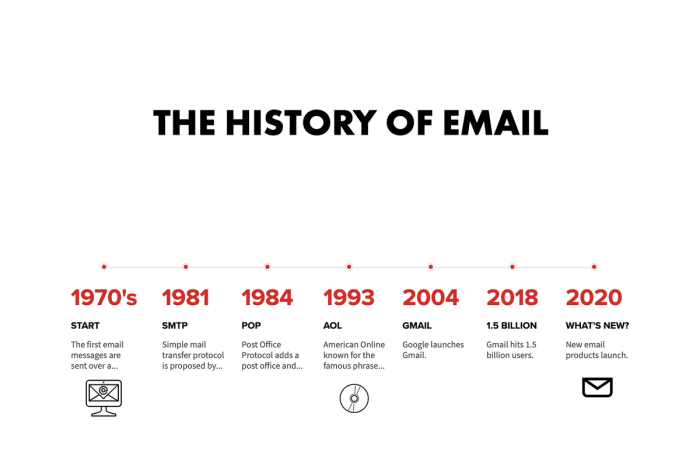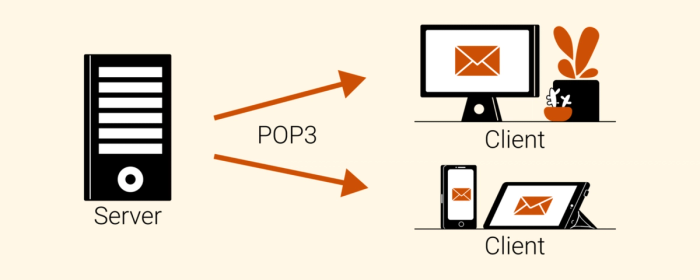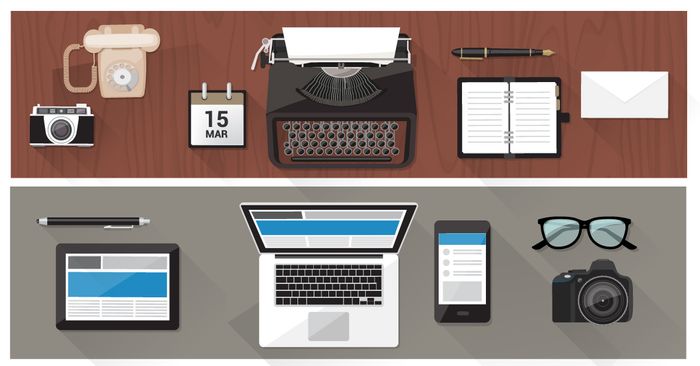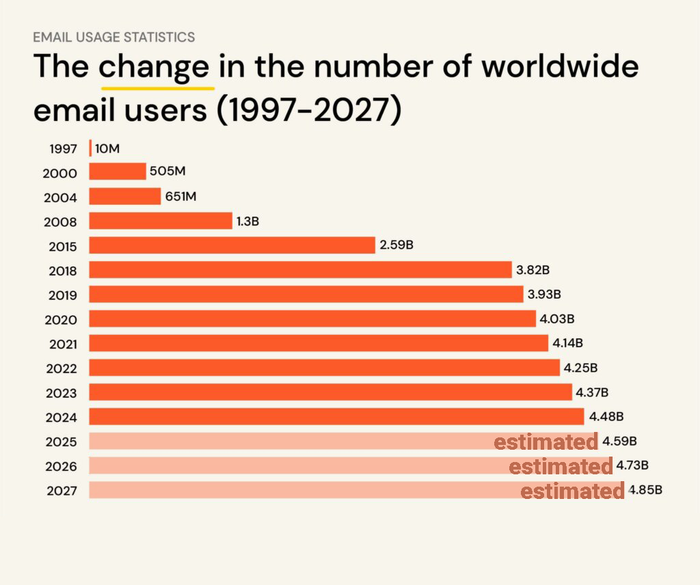Evolution of Email and What the Future Holds
Digital communication mediums are in wide variety nowadays, and it's easy to overlook some of the newer technologies emerging each day. However, one digital communication channel has the power to keep every generation together: email.
The first email was sent by Ray Tomlinson in 1971. Tomlinson, a computer engineer, is credited with using the "@" symbol to designate email addresses on ARPANET. Why have people chosen email as the main communication channel for over five decades? How did a platform that started with limited text evolve into a complex structure with its own unique UI design, email builders, and email templates? Let’s discuss.
We'll look at how email evolved from a basic tool for taking notes on personal computers to a worldwide network that connects people across several platforms. From its simple beginnings, email has grown to include AI-powered features that simplify our everyday duties and increase productivity. Now, let’s unpack the past, present, and future of email.
The Origins of Email
Email is the real titan of modern communication tools. We can confirm this by focusing on when did emails came out Because they go further than one may expect. The email originated in the 1960s at the Massachusetts Institute of Technology (MIT). During this time, computers were not portable gadgets that could be brought to a coffee shop; instead, they were enormous devices used by numerous people. In 1965, Noel Morris and Tom Van Vleck pioneered a method for passing messages among coworkers who shared a computer, laying the groundwork for what would become email.

In the early 1970s, Ray Tomlinson, an ARPANET project contributor, sent the first email, which changed interpersonal communication. He inserted the @ sign to separate the user's name from the destination address, thus establishing the present email address format. This innovation transformed communication dynamics. So, when did emails start being used and become ordinary in our daily lives?
It took almost a decade for email to become popular among users. Email started being effectively used in the 1980s, and during that time, it became the go-to method for professional communications and one of the most important channels for personal communications. By the 1990s, web-based email services like Yahoo and Hotmail had arisen, democratizing email use. The Internet Mail Access Protocol (IMAP) was introduced in 1988, allowing users to access their email from numerous devices with increasing ease.
Gmail revolutionized email in 2004 when it introduced a gigabyte of storage, creating a new standard. Today, web-based services like Gmail and Microsoft Outlook dominate the market, demonstrating email's continual growth.
Technological Foundations
We have given a brief introduction to some email protocols that are useful for users above. Now, we can discuss how these protocols help the growth and standardization of email further.
Email communication is based on a set of protocols that guarantee messages are effectively transported, accessed, and maintained across several platforms. Understanding SMTP, MIME, IMAP, and POP3 is critical to understanding how contemporary email systems work effortlessly.
Simple Mail Transfer Protocol (SMTP)
SMTP plays a key role in establishing how emails are sent from the sender to the recipient's email server. SMTP specifies guidelines for email relaying between servers, ensuring that messages are delivered correctly and quickly. This protocol is required for the smooth transmission of emails over multiple networks and servers, and it serves as the foundation of email communication.
Multipurpose Internet Mail Extensions (MIME)
MIME expands SMTP by enabling the transmission of a wide range of data types over email, including audio, video, images, and application software. Therefore, for crafting infographics or incorporating various media types while transmitting both ASCII and non-ASCII text. This expansion is required for the diversified and multimedia-rich communication that we demand today, especially in email marketing.

Internet Message Access Protocol (IMAP)
IMAP, which is now in its fourth version (IMAP4), is intended to access emails from numerous devices. It saves emails on a distant server and downloads them as needed when the recipient opens them. This enables users to view and synchronize their messages from any device and location. Therefore, it's fair to say that email protocols like this are a real lifesaver in today's world of multiple devices, offering indispensable support and functionality.
Post Office Protocol 3 (POP3)
POP3 is an easier method for accessing emails, as it downloads them to a local computer to view their electronic mail history. Once recovered, emails are normally erased from the server, enabling users to view them offline. This protocol is useful for users with restricted internet access since it does not need a continual connection to the server. POP3's simplicity and low dependence on constant internet connections make it a popular option for many people who only use one device for email access.

When Did Email Become Popular?
In the 90s, personal computers began to take their place in businesses and even homes. This significant shift in work routines made digital and well-documented communication techniques essential. Web-based email services laid the foundation for modern communication systems.
Email gained popularity in the mid-90s with the introduction of commercial and public email systems. The emergence of platforms such as Hotmail and Yahoo Mail made email available to the general public by providing user-friendly interfaces and free email accounts.
Hotmail, which debuted in 1996, was one of the first web-based services that enabled users to access their email from any computer with an internet connection. Yahoo Mail followed in 1997, becoming famous for its large storage capacity and simplicity of use. These breakthroughs were milestone moments in the history of email, leading to its quick acceptance and growth, which we use in personal communication or professional uses such as marketing.
Email's Impact on Communication
Email has transformed communication by revolutionizing both personal and business interactions. It provides exceptional speed and ease, allowing for quick communication and exchange regardless of where you are. This has resulted in an important shift in how people communicate, with conventional mail being largely displaced by email for routine interaction.
Furthermore, email has contributed to the expansion of digital marketing, allowing businesses to engage with worldwide audiences in a way that is effective and affordable.
At the start of the 2000s, social media platforms did not exist, restricting audience reach, and conventional media remained mostly localized; however, with email lists and strategies for advertising, a new, cost-effective, and engaging channel arose, replacing old telemarketing approaches. This is the era when different parts of emails have been recognized, and entities like CTAs and email banners have been born. With all of these innovations, it is not hard to understand how email has changed the world.

The Future of Email
With its 50-something years of use, it is safe to say that email’s place in our lives is secured. While it functioned as an early competitor of modern communication platforms, it also has potential for future innovation.
Email communication is often seen as more professional due to its message-filtering features. Concerns about spam emails, which might contain personal information, have long existed. However, with the development of improved filtering technology, the possibility of getting risky or undesired emails has decreased significantly.
Writing an email body might take some effort, especially when you want to express details efficiently. Looking forward, innovations like AI integration in writing and the development of visual infographics make it easier to generate messages based on prompts, optimizing communication efforts.
Emails connect all of our technical devices and accounts to each other. Therefore, you should feel the need to be extra careful about security problems.
Emerging technologies offer improved security methods to safeguard email, device, and account information, assuring the best protection for personal data. The future of email shows a shift towards multi-layered security methods that ensure exclusive access to specific user data.
Trends and Predictions on the Future of Email
Even though there are numerous tools available for digital marketing and business communication, finding a universal, secure, fast, and free solution remains challenging. Social media marketing tools, in particular, require constant updates to keep up with changing algorithms.

Email, on the other hand, offers a free, user-friendly, and broad-reaching method of marketing. The future of email recognizes the difficulty in creating varied templates for different target audiences. Thus, the future holds the promise of automated and personalized email designs tailored specifically for diverse audiences.
For example, once you had to know how to write HTML and CSS to create visually appealing email templates. Even then, making your design responsive and compatible with every email provider required lots of knowledge. Today, you can generate email templates just by dragging and dropping. Email builders like Tabular allow everyone to design state-of-the-art email templates.
In our visually-driven world, traditional text-based emails are becoming outdated. However, with mobile optimization and multimedia content, it is possible to create visually appealing and engaging emails. Therefore, especially for marketing purposes, staying updated on email design trends and future innovations is crucial.
The Evolution of Tenses in Emails
Early Email Communication (1970s-1980s)
Email communication wasn't always as user-friendly as it is today. When it first emerged in the 1970s, early email interactions were dominated by formal language and past tense conventions, reflecting the format of traditional memos or letters, which were considered the standard rules.
Today, the language of emails has evolved beyond basic grammar rules to encompass marketing practices. This includes choosing the best CTAs for email templates, crafting effective headers, and using abbreviations and acronyms in professional emails. These elements have created a new language that is both understandable and effective for all users.
However, the invention of spam emails also dates back to this era. This practice involved sending unsolicited bulk emails promoting products or services, which quickly became a nuisance for users. Over time, spamming tactics evolved, leading to the development of anti-spam measures to mitigate its impact.
Rise of Internet and Personal Email (1990s)
During the 1990s, as internet use became more personal, email communication shifted to the present tense. This change reflected a desire for more immediate and conversational interactions akin to real-time conversations rather than formal letter writing. Thus, it can be said that this period marked the transformation of email communication into a more dynamic medium.
Another significant milestone from this time was the first email sent from space. In 1991, astronaut Shannon Lucid sent an email from the Russian space station Mir to the United States. This historic event marked the beginning of email beyond Earth, showcasing the expanding reach and impact of digital communication technologies.
Dot-com Boom and Professional Communication (Late 1990s-2000s)
With the dot-com boom taking off between the 1990s and early 2000s, email became essential for professional communication. As rapid communication became crucial in the business world, the language shifted to a more professional present tense for ongoing activities.
Also, the future tense became widely used for planning purposes, allowing professionals to establish expectations and explain potential activities and objectives. In contrast, the past tense was often employed to summarize completed activities and achievements.
Email as Primary Business Tool (2000s-2010s)
With the introduction of mobile phones and text messaging, the linguistic nuance in email communication shifted once again. From the 2000s to the 2010s, email became the main company tool, characterised by greater informality and the adoption of an instant messaging style. This development mirrored an increasing focus on business efficiency and speedy communication. In addition, email communication during this time period often used a dynamic mix of tenses, combining past, present, and future tenses to express a feeling of urgency and progress. This hybrid approach to tense use allowed professionals to communicate effectively while adjusting to today's fast-paced corporate situations.
Modern Email Communication (2010s-Present)
As we get closer to the present day, we may see how email communication began to mirror a real-time conversation. This enabled a more casual and approachable tone of communication in both professional and personal settings. The continuous present and future tenses were frequently used to express continuing acts and future intentions, respectively, giving email conversation a feeling of continuity. The combination of tenses and casual tone represented a shift towards more active and expressive ways of communicating to provide receivers with a more engaging experience.

Impact of Remote Work and Real-time Collaboration Tools (2020s)
FYI, we need to finalize the project report by EOD. Please ensure that all updates are incorporated, and send the final draft to me ASAP. Seem familiar? The language in emails has evolved just like everything else. It has gotten faster; you wouldn't have seen email acronyms back in the 1970s.
In the 2020s, remote work and real-time collaboration tools changed the evolution of email communication, emphasizing real-time updates. The present tense became extensively employed, highlighting the importance of remote collaboration and the need for current information.
Email and instant messaging systems become merged, resulting in a hybrid communication style that combines the formality of instant messaging. This integration allowed for more fluid and dynamic exchanges. In addition, future-oriented planning became increasingly important in remote work scenarios. Future-tense emails became popular, allowing people to efficiently express objectives, deadlines, and expectations.
As a consequence, the development of tense changes in email tone throughout the 2020s mirrored the changing nature of remote work and cooperation, emphasizing real-time updates, mixed communication styles, and forward-thinking planning to support successful communication in virtual work contexts.
Email vs. Other Communication Tools
By reviewing the evolution of email's function, we can see why is email so important to modern communication. Email provides a more official and organized platform, distinguishing it from social networking and messaging applications. While texting applications provide quick exchanges, email allows for longer-form communication, such as attachments, documents, and long messages that demand careful analysis.
Email is seen as a more dependable medium for documentation, maybe owing to its broad usage or 50-year history. Unlike conversations on social media or messaging apps, which are temporary, emails serve as a permanent record, making them useful for documentation and reference.
Moreover, email has expanded beyond basic text communications to include a wide variety of features such as file sharing, collaboration, and marketing. Email evolved from text messaging to become a multifaceted tool that supports numerous functionalities. Its ability to change and adapt has kept it relevant in an ever-changing digital context, ensuring it remains a cornerstone of modern communication.
Compared to messaging apps and other networking platforms, email is still a vital tool for professional communication, long-form correspondence, and documentation, making it an essential component of current communication strategy.
Conclusion
In conclusion, the rise of email from its early days at MIT to its current prevalence as a communication powerhouse shows an incredible journey. Email has fundamentally changed worldwide connection and collaboration, leaving an everlasting effect in both the personal and professional fields. Looking forward, the future of email offers further innovation and adaptability to satisfy consumers' ever-changing needs in an increasingly dynamic digital context.
To fully appreciate the potential of email, users must first understand how did email change the world. Understanding its revolutionary role in redefining communication concepts allows individuals and companies to plan for future changes. By keeping aware and adaptive, we can confidently and effectively manage the ever-changing email technologies.
If you are a business owner, emails are the closest you can get to your customers. Even though reaching out to one another has become easier over time, capturing their interest and staying in their memory is getting harder each day. Therefore, learning how to build your emails with different UI components, like effective CTAs for email templates, is more important than ever. Tabular allows you to build email templates that work seamlessly across all email providers and devices. What are you waiting for? Come test our email templates for free!